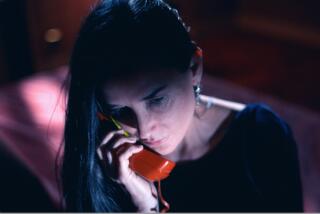Cannes: 6 Things to know about Ryan Gosling’s ‘Only God Forgives’
- Share via
CANNES -- The Ryan Gosling-Nicolas Refn collaboration “Only God Forgives” premieres to the media at the Cannes Film Festival on Wednesday morning before playing in a public gala Wednesday night. The movie, which reunites the star and director of the 2011 hit “Drive,” examines Julian (Gosling), an American boxing-gym operator and mid-level drug dealer in Bangkok who is thrust into a difficult spot when a brutal crime boss and dark angel of sorts (Vithaya Pansringarm) kills his brother. Should Julian seek justice or stay silent in the name of self-preservation?
As this is a Refn movie, there’s plenty of style and atmosphere (if not a lot of talking). Here are six elements/symbols you’ll want to take note of as the movie premieres at Cannes and rolls out to theaters and VOD on July 19.
PHOTOS: The scene at Cannes Film Festival 2013
Karaoke. When the dark angel commits a heinous act, he doesn’t prepare a meal with fava beans and chianti. He goes to a dingy Thai restaurant and sings a tinny karaoke song -- “as if in a phone booth,” in the words of score and music maestro Cliff Martinez -- in front of a mural of the Great Wall of China. Basically, when the dark angel is singing, something has usually gone down.
Quiet. Though the movie takes place in the normally lively city of Bangkok, there is an uneasy quiet over much of the film. There are rarely more than a few people on screen at the same time, and they usually let their knives and fists do the talking. Except for quick outbursts, Gosling’s Julian is pretty much silent, and the dark angel is even quieter.
Fighting. Julian runs a fighting gym, so there will be hand-to-hand combat. The most notable scene comes when Julian challenges the dark angel to a fight. Shot from all sorts of vertiginous angles, it doesn’t necessarily resolve in the way Gosling fights normally resolve.
Kristin. As in, Scott Thomas, who as Julian’s mother dominates and harasses him for his weakness in the face of his brother’s death. If the situation was reversed, she tells him, his brother would have brought back the killer’s head “on a platter.” The turn is unexpected for someone we’re using to seeing in more upscale dramatic roles. While the character was written as a Lady MacBeth/Ma Barker type, Scott Thomas wanted to push it to the next level, Refn said. And why so much Freud in the first place? Said the director: “All men struggle with their mothers. All men want to crawl back into the womb of their mothers. They’re also terrified of their mother. And it’s so easy for mothers to castrate sons.”
Thighs. As in, that body part between waist and knees. The image recurs several times in the movie, including with a prostitute/companion whom Gosling regularly sees, who rubs her hands erotically on them, and with a victim of the dark angel, who watches horrified as said angel thrusts chopsticks into them. There’s also plenty of hands -- committing murders, getting cut off, being washed of blood.
Red. As in, the color. There is often a reddish hue to the frame, and both the indoor spots and outdoor scenes feature red lanterns. And then of course, there’s the other kind of red: blood red. There’s plenty of that too.
ALSO:
Cannes 2013: Ryan Gosling, Croisette superstar?
Cannes 2013: With ‘Congress,’ Ari Folman votes for new audacity
Cannes 2013: ‘Drive’s’ Winding Refn keeps steering toward the bizarre
Follow me on Twitter at @ZeitchikLAT.
More to Read
Only good movies
Get the Indie Focus newsletter, Mark Olsen's weekly guide to the world of cinema.
You may occasionally receive promotional content from the Los Angeles Times.











